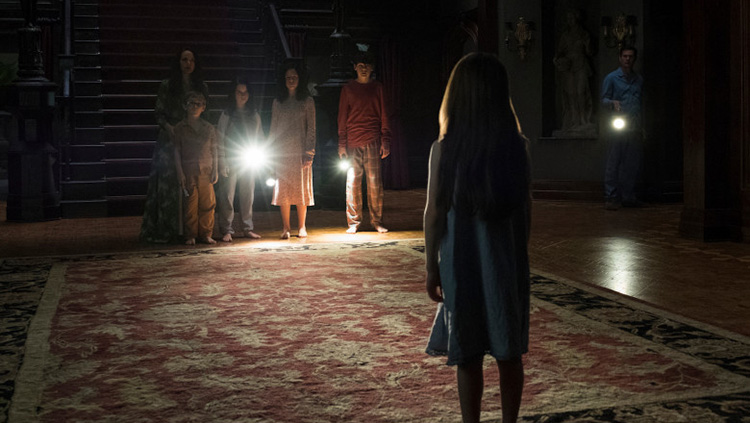Photo: Netflix
Horror isn’t just for Halloween entertainment. The undying genre has a devoted base of fans who crave the emotional response to jump scares, disturbing voyeur violence, and facing childhood fears. Traumatic events, like an unexpected death or sexual assault, can severely impact individuals, resulting in mental health issues like PTSD. Many of these traumas and disturbances are depicted in horror movies. Below, we explore just a few of the types of trauma and examples as to how they’re addressed in horror movies.
Cover Your Eyes: 14 Horror Movies Too Terrifying to Finish
Grief and Death
Death is obviously a huge component of horror, and sometimes characters have the chance to address the aftermath of a loss before they themselves are either killed or fighting for their lives. Contemporary examples include Neil Marshall’s The Descent, this year’s Hereditary (starring Toni Collete), and John Krasinski’s A Quiet Place.
Mike Flanagan’s new Netflix series The Haunting of Hill House gives a powerful look at the ways death can affect every part of someone’s life and how grief is a dangerous and sometimes uncontrollable emotion that continues to disrupt if left unresolved. Despite the paranormal setting, this is a show that’s very realistic, with each character being humanized through individual responses to grief, loss, and trauma.
The CW’s long-running series Supernatural, starring Jared Padalecki and Jensen Ackles, has spent years exploring how the Winchester brothers navigate trauma and grief (usually by shoving it as deep down as they can). Their story began with the death of their mother. Their lives forever changed as they were raised to be hunters by their revenge-driven father. Sam and Dean have suffered many losses over the years, and their unresolved trauma weighs heavily over their choices, especially when it comes to losing each other.
PTSD
David Gordon Green’s 2018 Halloween sequel is a refreshing example of PTSD in horror, providing a rare look at the aftermath of being a survivor after your friends were brutally slaughtered by a real-life Boogeyman. The film also addresses generational trauma in a way not usually presented in scary movies.
Jacob’s Ladder is another good example, specifically addressing the horrors of war. Jacob, played by Tim Robbins, has many symptoms of PTSD, including difficulty sleeping, outbursts, lack of memory, vivid flashbacks, and hypervigilance. There are other themes present, including non-consensual drug use and Purgatory, but the depiction of Jacob’s PTSD symptoms are a visceral representation of trauma.
Prepartum/Postpartum Depression
There are a few scary stories that work as metaphors for prepartum depression, such as the classic Roman Polanski film Rosemary’s Baby and the lesser-known British comedy horror Prevenge that explores the isolating side effects of prepartum depression. Depictions of postpartum depression are more common. In The Babadook, for example, the mother’s symptomatic resentfulness towards her son stems from her unresolved grief after her husband died in a car accident as she was in labor.
The child, Samuel, has a habit of acting out, which sometimes triggers his mother’s symptoms. The movie, with the help of its monster, directly confronts the raw nature of postpartum depression, its side effects, and the often unfair societal expectations placed on mothers and single parents.
Abuse
This trauma comes in many forms, including physical, sexual, emotional and psychological abuse as well as neglect. In the horror genre, abuse is usually part of one character’s specific story, such as in M. Night Shyamalan’s The Sixth Sense, AMC’s The Walking Dead, and in the 2017 adaptation of Stephen King’s IT.
Abuse can be a main focal point too, like in the film adaptation of Jack Ketchum’s novel The Girl Next Door, where a teen suffers unspeakably at the hands of her aunt (honestly, you can skip this one altogether).
Spooky Music: The 10 Best Horror Movie and TV Theme Songs
Bullying
In horror movies, bullying often ends in one of two ways: violence and/or death. Anyone who’s ever been bullied knows how traumatizing it is, and watching a bully do terrible things onscreen and then die gruesomely is like watching someone getting revenge on the victim’s behalf. We don’t want to condone violence, but the genre usually plays off of the distance fictionalized violence gives us.
Bullying is featured in horror projects like Unfriended, Stephen King’s Carrie and IT, Netflix’s Stranger Things, and Let the Right One In, or its English remake, Let Me In, in which the bullying crosses a criminal line (and helps desensitize us more to the bullies’ gruesome fates).
Natural or Manmade Disasters
There are several types of natural and manmade disasters that can result in trauma, and the horror genre usually leans towards animals, zombies, and/or apocalyptic events to showcase them. One of the first movies to do this is Alfred Hitchcock’s The Birds. These stories explore how characters attempt to avert, escape, or cope with the disaster and its aftermath.
Danny Boyle’s 28 Days Later is a perfect example of a contemporary horror disaster movie. Much like The Walking Dead and Fear the Walking Dead, the living are sometimes more terrifying than the monsters. As the dead or infected rage through the post-apocalyptic landscape, these stories explore the best and worst in humanity and how that trauma of massive loss and fear impacts them in a lawless, survival-driven society.
Sexual Assault
Sexual violence in horror movies is usually exploitive and used as shock value. It’s not uncommon to see sexual assault utilized as a plot point for revenge, such as in Wes Craven’s The Hills Have Eyes or the cult classic I Spit on Your Grave.
Wes Craven’s 1972 The Last House on the Left and the 2009 remake are the epitome of an assault-and-revenge story. They allow the victim’s family to take sweet and brutal vengeance out on the perpetrators with little focus on the actual victim’s experience. Sexual violence, if it really even has to be used onscreen, should be more than just a plot point or symbol, with more respect given to the survivor’s story.









